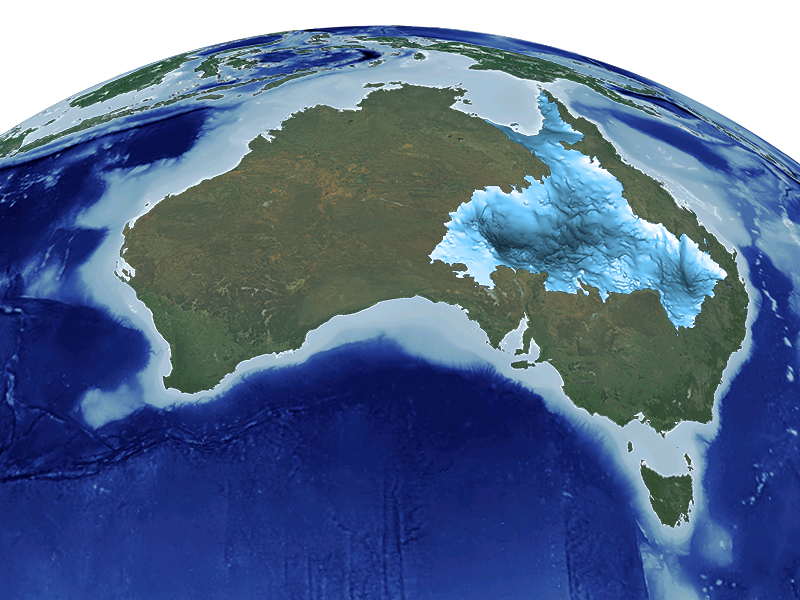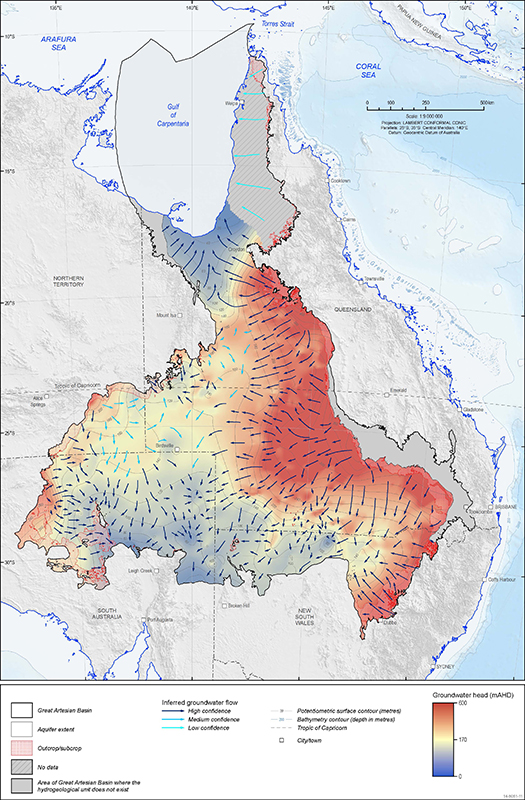Navigating Australia's largest groundwater resource
Page last updated:22 December 2015
The most comprehensive mapping report on Australia's largest groundwater basin has been developed in the form of an Atlas - providing valuable information to assist water managers and communities to make more informed decisions towards sustainable management of this vast water resource. The Hydrogeological Atlas of the Great Artesian Basin (Basin) draws together geological and hydrogeological data collected from the area and condenses it into a series of 55 maps, making the information much more accessible to water managers, researchers, industry, farmers, community groups and the general public.
Australia is the driest inhabited continent on the Earth and, per capita, is one of the largest users of water in the world. Australia draws upon a combination of surface water and groundwater for agriculture production, industry (including mining activities), and town and domestic supply. In many parts of Australia, groundwater is the only reliable water resource, and careful planning and management is critical to ensure sustainable use of this valuable water supply.
The Great Artesian Basin is Australia's largest groundwater system. Comprising around 20% of Australia's total landmass, the Basin covers most of Queensland, the north western parts of New South Wales, part of the Northern Territory and about half of South Australia. It is estimated to hold nearly 65,000 million megalitres of water, (about 130,000 Sydney Harbours) and is a key source of water for springs, many of which support unique ecosystems.
Access to groundwater from the Basin has also allowed a significant portion of arid Australia to be opened up to grazing. The groundwater resources contained within the Basin are, in many cases, the only reliable domestic and stock watering supply available to the many towns and properties, across the region.
Properly managing these groundwater resources, often for competing interests, requires an understanding of how the groundwater system works at a regional scale, and how water use in one State can impact on another. As the Basin is spread across Australian States and the Northern Territory, a cross-state coordinated guide to management the Great Artesian Basin Strategic Management Plan is in place - providing a framework for ensuring the sustainable use of this valuable water resource.
Groundwater from the basin is also a vital resource for many mining operations, hydrocarbon exploration and is in some instances used for irrigation. Future activities reliant on water throughout the region can only proceed with the guarantee of water access and an understanding of the impacts on the Basin and in line with the management strategy.
The Hydrogeological Atlas of the Great Artesian Basin builds upon existing knowledge and will assist State and Local Government decision makers in their water planning programs. It highlights in a clear, graphical way where the knowledge gaps are and can help Governments, industry and researchers to target future groundwater sampling programs.
The Great Artesian Basin covers most of Queensland, the north western parts of New South Wales, part of the Northern Territory and about half of South Australia
New atlas builds upon years of research
Geoscience Australia has undertaken extensive research over many years to establish an understanding of how groundwater is replenished and how it flows through the Basin. Over the past 130 years, a large amount of the water extracted has been lost to evaporation (up to 90%) through inefficient water distribution methods such as uncontrolled artesian bores and open bore drains bores to sustain livestock.
This wastage increased groundwater depressurisation of the Basin, and has led to some bores ceasing to flow - threatening springs and the survival of the unique ecosystems dependent upon them.
Geoscience Australia's research has been fundamental for the sustainable management of the Basin and preserving the natural environment that relies on the Great Artesian Basin to survive.
The Hydogeological Atlas of the Great Artesian Basin draws upon previous work undertaken by Geoscience Australia that has contributed to a number of projects, such as the CSIRO-led Great Artesian Basin Water Resource Assessment (GABWRA) project and Geoscience Australia's Carbon Capture and Storage project. Two key pieces of new work presented in this atlas are the up-to-date interpretations of the extent and thickness of the major aquifers and aquitards and the basin-wide perspective of the variation of water chemistry found within the major aquifers.
The new atlas presents a compilation of maps documenting some of the key regional geological, hydrogeological and hydrochemical aspects of the Great Artesian Basin. It provides insights into the current understanding of the regional geology and physical characteristics of the rocks and water contained within this vast groundwater basin and baseline information against which future changes can be assessed.
The atlas and associated datasets combine to form a valuable information resource base for water managers and communities to support informed water management decisions within the basin. It will help both water managers and communities to better understand the groundwater resources contained within the basin and to enable more effective evaluation of management activities. However, effective management of the groundwater within can only take place when we have an understanding of volume, flow, usage, impact and replenishment rates.
An interconnected system through the passage of time
One of the most important messages delivered through the atlas is that the Basin is not just one large groundwater aquifer, but in fact consists of multiple aquifers layered on top of each other. Today the Basin is known not to be a discrete isolated system, but to be interconnected in some areas with underlying and adjacent sedimentary basins and underlying fractured basement rocks.
Replenishment of the Basin is a complex process of water infiltrating and moving through the many sedimentary layers and occurs over millions of years. For example, along the western slopes of the Great Dividing Range in central Queensland, water from rainfall seeps into the exposed edges of the aquifers and flows downslope through the sandstone layers toward South Australia. It can takes millions of years for groundwater to flow hundreds of kilometres, which is why confident management of the basin is integral to ensuring the long term sustainability of this valuable resource.
The Atlas of the Great Artesian Basin is available now from the Geoscience Australia website. Each dataset is accompanied by a metadata statement that details the source datasets and methods used to produce the data and interpretations presented in each map.

